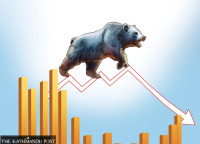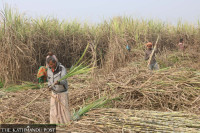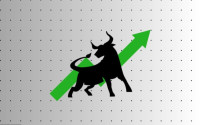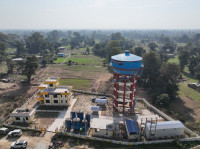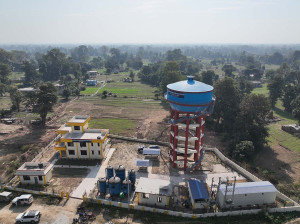Money
Nepal’s first Holstein calf expected to be born in Feb
Nepal received 100 heifers and eight bulls as a gift from South Korean farmers under the Milky Way project last December.
Sangam Prasain
Mali the cow is pregnant and will be delivering a calf on February 10 next year.
“If it's a male, it will go to the government’s nucleus bull-breeding herd. And if it's a female, it will stay in Sindhuli,” said Haewon Lee, executive director of Heifer International Korea that brought the cow to Nepal.
Holstein cows are the most recognised breed of dairy cattle with distinctive black-and-white or red-and-white markings.
Mali’s calf will be the first Nepali-born “pure Holstein” descended from the herd gifted by South Korean farmers to Nepali farmers last December.
The 100 heifers and eight bulls were received under the Milky Way project, a joint initiative of Nepal and South Korea, to establish a high-quality nucleus herd to modernise the dairy industry.
They were airlifted from South Korea, quarantined in Kathmandu and delivered to the farmers in Sindhuli, about 150 km east of the capital. Sindhuli farmers received 80 of the heifers.
Mali's owner Guna Kumari Ghimire of Rajapani-5, Kamalamai Municipality is excited. Mali is now 5 feet tall and weighs around 500 kg.
“In the beginning, it was difficult to handle her. She behaved like a wild animal. It was difficult to feed her too. But now, she has become a family member,” said Ghimire, a grade 12 teacher.
The heifers supplied in Sindhuli were impregnated through artificial insemination (AI).
Among the 80 heifers sent to Sindhuli, 37 are now pregnant. The spread of lumpy skin disease prevented timely AI of all heifers. According to Heifer International Nepal, five heifers died due to the lumpy skin disease.
Mali was made pregnant on May 4 through AI.
Maya, another heifer, is 18 months pregnant. She will be giving birth to a calf on June 4.
Farmers in Sindhuli are excited at the prospect of the first birth of the Holstein Friesian, an international breed or group of breeds of dairy cattle.
It originated in the Dutch provinces of North Holland and Friesland and Schleswig-Holstein in northern Germany. It is the dominant breed in industrial dairy farming worldwide, and is found in more than 160 countries.
The milk output of the breed exceeds 30 litres a day, which is more than three times what the improved variety of cows in Nepal now produce.
Sindhuli has a big plan to boost its dairy industry as it plans to build a modern dairy village.
The South Korean Ministry of Agriculture, Food and Rural Affairs Chung Hwang-keun is scheduled to visit Nepal on Wednesday evening to take stock of the situation of the heifers supplied to Nepali farmers.
He is scheduled to meet Prime Minister Pushpa Kamal Dahal on Thursday morning and President Ram Chandra Poudel in the afternoon.
The minister is also scheduled to sign a memorandum of understanding with Nepal’s Ministry of Agriculture and Livestock Development to boost the dairy and agriculture sectors.
“My minister is coming to ask what further support is needed,” said Lee, executive director of Heifer International Korea. “The visit also marks the strengthening of Nepal-South Korea relations.”
The two countries are celebrating the golden jubilee of the establishment of bilateral relations next year.
"Nepal has a huge potential to grow in the dairy sector, which currently contributes 8 percent to its GDP," said Lee.
“This is the beginning. Eventually, we want to establish a pasteurised milk processing plant. The Nepal government also needs to invest in it.”
Pasteurised milk is dairy milk that is heated and cooled using a simple heating process that makes milk safe to drink before it is packaged and shipped to grocery stores.
In Nepal, raw milk—straight from the cow or buffalo—does not go through the pasteurisation process.
“We have also planned to establish a total mixed ration (TMR) plant and a chilling centre in Sindhuli,” said Lee.
TMR is a method of feeding cows that combines feeds formulated to a specific nutrient content into a single feed mix. It is composed of forages, grains, protein supplements, minerals and vitamins.
“Balanced ration is a prerequisite for successful dairy farming,” said Lee.
According to Heifer International Nepal officials, the mayor of Kamalamai Municipality has allotted lands to establish the TMR plant and chilling centre as part of the plan to make Sindhuli a model village for the dairy industry.
As per estimates, a Holstein cow can give 10,000 litres of milk annually, compared to 800 litres from local breeds. Improved breeds give 2,800 litres of milk annually in Nepal.
A Holstein cow generally gives milk for 10 months before they are given a period of rest of about two months before the next calf is born.
The heifer project expects to have 250,000 farmers own Holstein cows within five years.
Ram Hari Karki, a local of Upper Rajpani, Kamalamai Municipality, owns two Holstein cows—one gifted by Heifer and another he brought from India.
“The second one is a cross-breed,” said Karki.
He spent Rs150,000 to bring the cross-breed from India, including the transportation cost.
“An Indian businessman delivered the cow [across the border] and I brought it here. There is a difference. The pure Holstein is a bit taller.”
Karki says that he currently earns Rs25,000 monthly from the cross-breed. Spending for its feed and medicine comes to Rs10,000 monthly. “I make a net profit of Rs15,000 monthly by selling the milk.”
He is also waiting for the result of the pure Holstein when it starts giving milk after a few months. “We can compare the differences between the pure breed and the cross-breed.”
As per the practice, under the “passing on the gift” initiative of Heifer International, the first calf should be gifted.
“The second and third can be sold, but it should be within the area so that we can keep track of them,” said Lee. “We have secured 500 new households for the first and second offspring.”
Lack of bulls for high-quality semen and lack of a systematic and sustainable genetic improvement programme are the primary hindrances to the transformation of Nepal’s dairy industry, officials said.
Currently, Nepal’s milk yield of dairy animals is poor. The animals have low productivity.
Cross-bred cows in Nepal produce around 9 litres of milk daily. The government's breed improvement programme lacks a systemic approach and genetic resources.
Nepal’s attempt to import high-quality animal breeds could not succeed over the past several decades due to the prohibitory policies of foreign countries to export genetic resources.
In Nepal, a 2020 study estimated that a Nepali consumes 72 litres of milk and dairy products annually, while the recommended requirement is 91 litres.
The Department of Livestock Services estimates that the milk deficit will likely worsen as the growth of dairy products, which is 4 percent annually, is not keeping pace with the growth in demand of 8 percent annually.
Overall milk production is relatively low due to poor genetic potentials, poor feeding and a poor health care system.
According to the Ministry of Agriculture and Livestock Development, Nepal produced 2.47 million tonnes of milk in the fiscal year 2020-21.




 14.12°C Kathmandu
14.12°C Kathmandu
